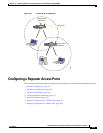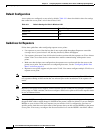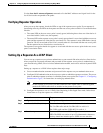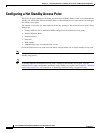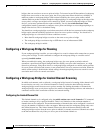
19-11
Cisco IOS Software Configuration Guide for Cisco Aironet Access Points
OL-29225-01
Chapter 19 Configuring Repeater and Standby Access Points and Workgroup Bridge Mode
Configuring a Hot Standby Access Point
Beginning in Privileged Exec mode, follow these steps to enable hot standby mode on an access point:
Command Purpose
Step 1
configure terminal Enter global configuration mode.
Step 2
iapp standby mac-address Puts the access point into standby mode and specifies the MAC
address of radio on the monitored access point.
Note When you configure a 1200 Series access point with two
radios to monitor a 1200 Series access point with two
radios, you must enter the MAC addresses of both the
monitored 2.4-GHz and 5-GHz radios. Enter the 2.4-GHz
radio MAC address first, followed by the 5-GHz radio
MAC address.
Note The MAC address of the monitored access point might
change if a BSSID on the monitored unit is added or
deleted. If you use multiple BSSIDs on your wireless
LAN, check the status of the standby unit when you add
or delete BSSIDs on the monitored access point. If
necessary, reconfigure the standby unit to use the
BSSID’s new MAC address.
Note Hot standby is not supported on the BR1410 configured
for AP mode.
Step 3
interface dot11radio { 0 | 1 } Enter interface configuration mode for the radio interface.
The 2.4-GHz radio and the 2.4-GHz 802.11n radio is 0.
The 5-GHz radio and the 5-GHz 802.11n radio is 1.
Step 4
ssid ssid-string Create the SSID that the standby access point uses to associate to
the monitored access point; in the next step designate this SSID
as an infrastructure SSID. If you created an infrastructure SSID
on the monitored access point, create the same SSID on the
standby access point, also.
Step 5
infrastructure-ssid [optional] Designate the SSID as an infrastructure SSID. The standby uses
this SSID to associate to the monitored access point. If the
standby access point takes the place of the monitored access
point, infrastructure devices must associate to the standby access
point using this SSID unless you also enter the optional keyword.
Step 6
authentication client username
username
password password
If the monitored access point is configured to require LEAP
authentication, configure the username and password that the
standby access point uses when it performs LEAP authentication.
This username and password must match the username and
password that you set up for the standby access point on the
authentication server.
Step 7
exit Exit SSID configuration mode and return to radio interface
configuration mode.
Step 8
iapp standby poll-frequency
seconds
Sets the number of seconds between queries that the standby
access point sends to the monitored access point’s radio and
Ethernet ports. The default poll frequency is 2 seconds.



